The Integrated Quantum Optical Circuits Market is estimated to be valued at USD 2.4 billion in 2025 and is projected to reach USD 4.5 billion by 2035, registering a compound annual growth rate (CAGR) of 6.5% over the forecast period.
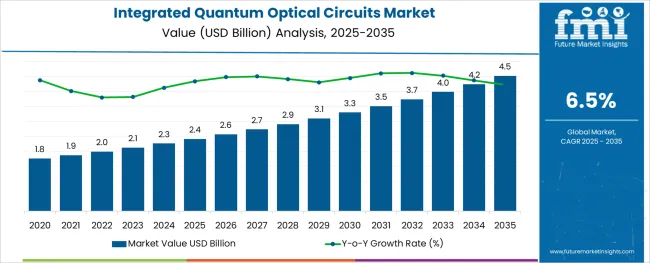
The integrated quantum optical circuits market is growing steadily due to advancements in quantum computing and photonic technologies. Increasing investment in next-generation computing solutions has accelerated the development of integrated circuits capable of manipulating quantum states of light. Silicon photonics has emerged as a leading material choice because it offers compatibility with existing semiconductor manufacturing processes and enables high scalability.
Research institutions and technology developers are focusing on improving circuit efficiency and miniaturization to support practical quantum applications. The demand for faster and more reliable quantum processors is driving innovation in integrated optical components, enabling better control over photons.
Applications in quantum computing have been particularly influential in expanding the market as the need for advanced quantum communication and information processing increases. The future of this market looks promising with ongoing technological breakthroughs and growing interest from both academia and industry.
The market is segmented by Material Type, Component, and Application and region. By Material Type, the market is divided into Silicon Photonics, Indium Phosphide, Silica Glass, Lithium Niobate, and Gallium Arsenide. In terms of Component, the market is classified into Waveguides, Directional Coupler, Active Components, Light Sources, and Detectors. Based on Application, the market is segmented into Quantum Computing, Optical Fiber Communication, Optical Sensors, Bio Medical, and Other Applications. Regionally, the market is classified into North America, Latin America, Western Europe, Eastern Europe, Balkan & Baltic Countries, Russia & Belarus, Central Asia, East Asia, South Asia & Pacific, and the Middle East & Africa.
The market is segmented by Material Type, Component, and Application and region. By Material Type, the market is divided into Silicon Photonics, Indium Phosphide, Silica Glass, Lithium Niobate, and Gallium Arsenide. In terms of Component, the market is classified into Waveguides, Directional Coupler, Active Components, Light Sources, and Detectors. Based on Application, the market is segmented into Quantum Computing, Optical Fiber Communication, Optical Sensors, Bio Medical, and Other Applications. Regionally, the market is classified into North America, Latin America, Western Europe, Eastern Europe, Balkan & Baltic Countries, Russia & Belarus, Central Asia, East Asia, South Asia & Pacific, and the Middle East & Africa.
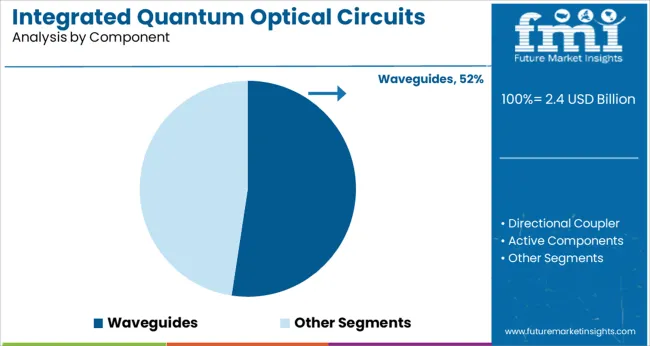
The silicon photonics segment is expected to hold 46.8% of the integrated quantum optical circuits market revenue in 2025. This segment’s growth is attributed to silicon’s compatibility with existing microelectronics fabrication methods and its potential to integrate photonic and electronic components on a single chip. Silicon photonics allows for efficient light manipulation while supporting mass production, making it attractive for commercial quantum devices.
Furthermore, the material’s stability and cost-effectiveness have encouraged adoption in research and commercial quantum technologies.
The development of new silicon-based devices continues to improve performance and integration density, which supports the segment’s leading position.
Waveguides are projected to account for 52.4% of the market revenue in 2025, establishing them as the dominant component segment. Their growth is driven by their critical role in guiding and controlling photons within quantum circuits with minimal loss. Waveguides enable precise routing of light signals, essential for quantum information processing and secure communication.
Advances in fabrication techniques have improved waveguide performance, allowing for compact and scalable circuit designs.
These improvements have made waveguides a fundamental building block for integrated quantum optical systems, fueling their widespread use.
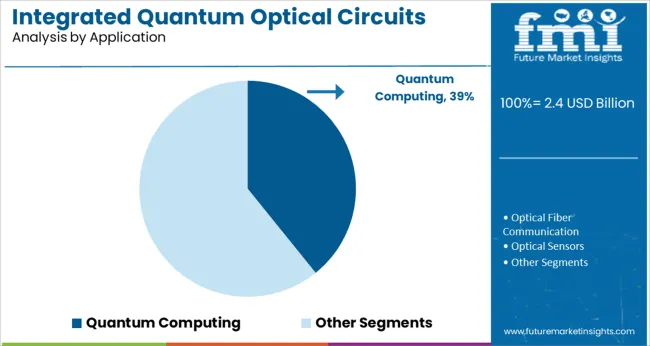
The quantum computing segment is anticipated to contribute 39.2% of the market revenue in 2025, leading applications of integrated quantum optical circuits. Growth in this segment is supported by the increasing need for quantum processors capable of solving complex problems beyond classical computers.
Integrated optical circuits provide pathways for implementing qubits and quantum gates with photons, which are less susceptible to noise compared to other quantum systems. The push for more efficient and scalable quantum computing platforms has driven investment in this area.
As practical quantum computers become more viable, demand for integrated optical circuits tailored for quantum computing is expected to expand significantly.
Many factors are driving the market for integrated quantum optical circuits, and one of the major factors is the surge in the demand for better and faster internet connectivity. As an integrated quantum optical circuit is one of the components that helps solve the purpose, the market for integrated quantum optical circuits is increasing at a good rate.
Another driver that helps in the increase of the integrated quantum optical circuits market is that there are regions that are having a transition from traditional technologies to new technologies in the optical fiber domain. So, this transition acts as a driver for the integrated quantum optical circuits market as it would increase the market at a high rate in some regions and have a good show on the global market as well.
Some of the restraints in integrated quantum optical circuits markets have been related to the design complexity of integrated quantum optical circuits. The designs of the integrated quantum optical circuits are fairly complex to manufacture and hence attract fewer manufacturers in the integrated quantum optical circuits market, this, in turn, generates fewer opportunities in some regions and slows down the growth of the integrated quantum optical circuits market.
Another restraint for the integrated quantum optical circuits market has been the high initial cost to adopt the specific circuits in the regions. The regions like North America as per their spending could easily afford to have integrated quantum optical circuits whereas, in the regions like MEA, it would be difficult to adopt the same easily.
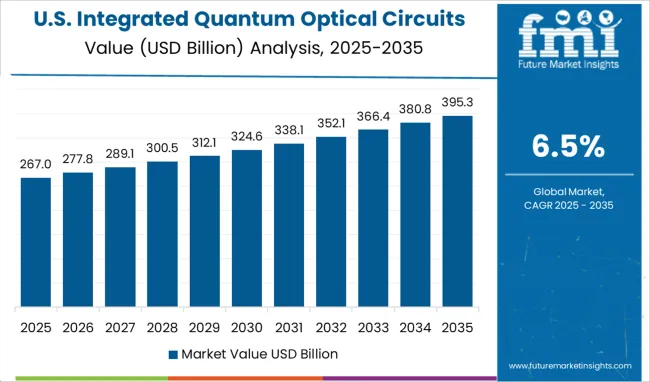
North America captured nearly 43% share 2024 of the integrated quantum optical circuits market, backed by the swelling adoption of PIC-based products, particularly in the data centres and WAN applications of optical fiber communication. For instance, in March 20251, R&M, the globally active developer and provider of cabling systems for high-quality network infrastructures, launched fiber-to-the-home (FTTH) products and services in North America, providing end-to-end connectivity from the central office to the premises.
Besides, in terms of value, the leading of integrated quantum optical circuits will further elevate the growth of the integrated quantum optical circuits market in the region throughout the conjecture period.
This market growth is propelled by the early adoption of new technologies, high spending on R&D, and rapid innovations in the province powered by the presence of large USA-based companies in the integrated quantum optical circuit industry.
A recently published report by Future Market Insights reveals that the North American market for Integrated Quantum Optical Circuits is projected to follow an expansion rate of 6.5% throughout the forecast period.
Asia-Pacific is projected to exhibit substantial growth in the integrated quantum optical circuits market owing to the occurrence of tier-1 creators. Furthermore, the upsurge in the communication industry and major development in the optical fiber communication segment are further estimated to boost the growth of the integrated quantum optical circuits market in the region in the forthcoming years.
For instance, In May 2025, A new high-performance submarine cable is being manufactured to enhance connectivity between Hong Kong, China, and Southeast Asia. China Mobile International Limited, China Unicom Global, and Converge Information and Communications Technology Solutions Inc. have all reaffirmed their partnership to construct and operate the South-East Asia Hainan - Hong Kong Express Cable System (SEA-H2X).
CMI continues to emphasize digital economy development by expanding its digital infrastructure including cable systems, PoPs, and data centers. The company has been investing in various submarine cables due to the soaring demand for data usage in the Asia-Pacific region. Rendering these factors, the APAC market for Integrated Quantum Optical Circuits is forecast to register a growth rate of nearly 6.6% during the assessment period, reveals the Future Market Insights report.
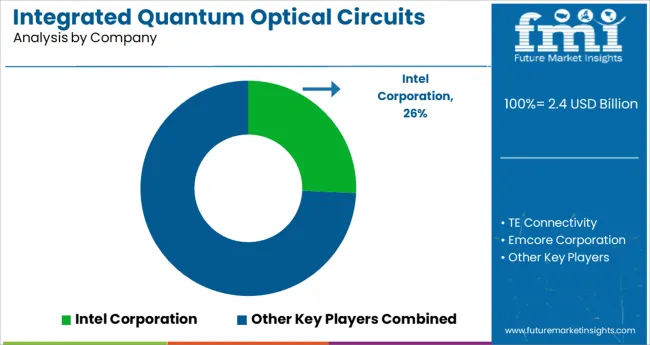
Prominent players in the global Integrated Quantum Optical Circuits market are TE Connectivity, Intel Corporation, Emcore Corporation, Aifotec AG, Ciena Corporation, Finisar Corporation, Infinera Corporation, Oclaro Inc., Luxtera, Inc., and Nanophotonics Corporation among others. Recent key developments among players include:
| Report Attribute | Details |
|---|---|
| Growth Rate | CAGR of 6.5% from 2025 to 2035 |
| Market Value in 2025 | USD 1.99 Billion |
| Market Value in 2035 | USD 3.75 Billion |
| Base Year for Estimation | 2024 |
| Historical Data available for | 2020 to 2024 |
| Forecast Period | 2025 to 2035 |
| Quantitative Units | Revenue in million, Volume in Kilotons, and CAGR from 2025 to 2035 |
| Report Coverage | Revenue Forecast, Volume Forecast, Company Ranking, Competitive Landscape, Growth Factors, Trends, and Pricing Analysis |
| Segments Covered | Material Type, Component, Application, Region |
| Regions Covered | North America; Latin America; Europe; Asia Pacific; The Middle East and Africa |
| Key Countries Profiled | USA, Canada, Brazil, Mexico, Germany, UK, France, Spain, Italy, Russia, BENELUX, Japan, China, South Korea, GCC, South Africa, Turkey |
| Key Companies Profiled | TE Connectivity; Intel Corporation,; Emcore Corporation,; Aifotec AG,; Ciena Corporation,; Finisar Corporation,; Infinera Corporation,; Oclaro Inc.,; Luxtera, Inc.,; Neophotonics Corporation; Others |
The global integrated quantum optical circuits market is estimated to be valued at USD 2.4 billion in 2025.
It is projected to reach USD 4.5 billion by 2035.
The market is expected to grow at a 6.5% CAGR between 2025 and 2035.
The key product types are silicon photonics, indium phosphide, silica glass, lithium niobate and gallium arsenide.
waveguides segment is expected to dominate with a 52.4% industry share in 2025.






Our Research Products

The "Full Research Suite" delivers actionable market intel, deep dives on markets or technologies, so clients act faster, cut risk, and unlock growth.

The Leaderboard benchmarks and ranks top vendors, classifying them as Established Leaders, Leading Challengers, or Disruptors & Challengers.

Locates where complements amplify value and substitutes erode it, forecasting net impact by horizon

We deliver granular, decision-grade intel: market sizing, 5-year forecasts, pricing, adoption, usage, revenue, and operational KPIs—plus competitor tracking, regulation, and value chains—across 60 countries broadly.

Spot the shifts before they hit your P&L. We track inflection points, adoption curves, pricing moves, and ecosystem plays to show where demand is heading, why it is changing, and what to do next across high-growth markets and disruptive tech

Real-time reads of user behavior. We track shifting priorities, perceptions of today’s and next-gen services, and provider experience, then pace how fast tech moves from trial to adoption, blending buyer, consumer, and channel inputs with social signals (#WhySwitch, #UX).

Partner with our analyst team to build a custom report designed around your business priorities. From analysing market trends to assessing competitors or crafting bespoke datasets, we tailor insights to your needs.
Supplier Intelligence
Discovery & Profiling
Capacity & Footprint
Performance & Risk
Compliance & Governance
Commercial Readiness
Who Supplies Whom
Scorecards & Shortlists
Playbooks & Docs
Category Intelligence
Definition & Scope
Demand & Use Cases
Cost Drivers
Market Structure
Supply Chain Map
Trade & Policy
Operating Norms
Deliverables
Buyer Intelligence
Account Basics
Spend & Scope
Procurement Model
Vendor Requirements
Terms & Policies
Entry Strategy
Pain Points & Triggers
Outputs
Pricing Analysis
Benchmarks
Trends
Should-Cost
Indexation
Landed Cost
Commercial Terms
Deliverables
Brand Analysis
Positioning & Value Prop
Share & Presence
Customer Evidence
Go-to-Market
Digital & Reputation
Compliance & Trust
KPIs & Gaps
Outputs
Full Research Suite comprises of:
Market outlook & trends analysis
Interviews & case studies
Strategic recommendations
Vendor profiles & capabilities analysis
5-year forecasts
8 regions and 60+ country-level data splits
Market segment data splits
12 months of continuous data updates
DELIVERED AS:
PDF EXCEL ONLINE
Integrated Trimming and Forming System Market Size and Share Forecast Outlook 2025 to 2035
Integrated Traffic System Market Size and Share Forecast Outlook 2025 to 2035
Integrated Chemistry Systems Market Size and Share Forecast Outlook 2025 to 2035
Integrated Mineral Analyzer Market Size and Share Forecast Outlook 2025 to 2035
Integrated Motor Protector Market Size and Share Forecast Outlook 2025 to 2035
Integrated Universal Integrated Circuit Card (iUICC) Modules Market Size and Share Forecast Outlook 2025 to 2035
Integrated SIM (iSIM) Market Size and Share Forecast Outlook 2025 to 2035
Integrated 3D Radar Market Size and Share Forecast Outlook 2025 to 2035
Integrated UPS Market Size and Share Forecast Outlook 2025 to 2035
Integrated Labeling System Market Size and Share Forecast Outlook 2025 to 2035
Integrated Graphics Chipset Market Analysis by Device Type, Industry Vertical, and Region – Growth, Trends, and Forecast from 2025 to 2035
Integrated Food Ingredients Market Analysis -Size, Share & Forecast 2025 to 2035
Integrated Gas System Market Growth – Trends & Forecast 2025 to 2035
Integrated Passive Devices (IPDs) Market
Integrated CMOS Tri-gate Transistor Market
AI-Integrated Blood Analyzers Market Analysis - Size, Share, and Forecast Outlook 2025 to 2035
Drug Integrated Polymer Fibers Market Size and Share Forecast Outlook 2025 to 2035
RFID-Integrated Smart Packaging Market Analysis - Size, Share, and Forecast Outlook 2025 to 2035
Fully Integrated Dishwasher Market Size and Share Forecast Outlook 2025 to 2035
Power Integrated Modules Market Trends – Growth & Forecast through 2034

Thank you!
You will receive an email from our Business Development Manager. Please be sure to check your SPAM/JUNK folder too.
Chat With
MaRIA